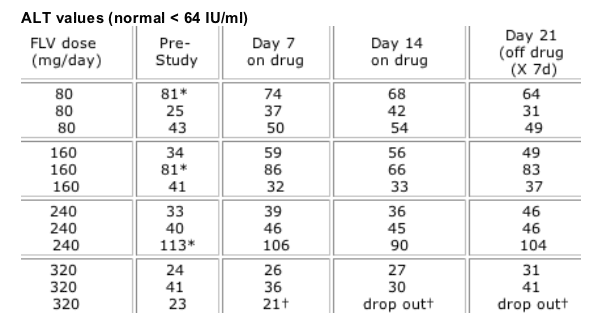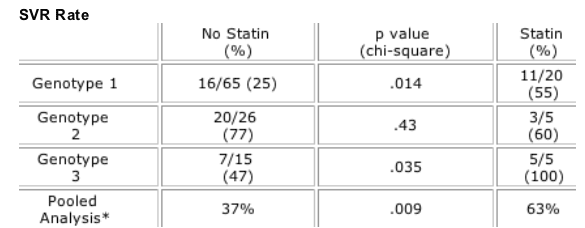 |
 |
 |
| |
Statin Improved PegIFN/RBV SVR Rate, Improve ALTs in HCV+
|
| |
| |
Reported by Jules Levin
DDW, Washington DC, May 19-22, 2007
Statins Improve ALT values in Chronic Hepatitis C Patients with Abnormal Values
T. Bader1; M. Madhoun1; S. Rizvi1; K. Seres1; J. Fazili1
1. VA Medical Center, University of Oklahoma, Oklahoma City, OK, USA.
There are no prospective reports of HCV patients taking statins. FDA inserts for statins list "active liver disease" as a contraindication, but the meaning of this is unclear. As part of an IRB and FDA approved 14 day study looking at the antiviral effect of fluvastatin (FLV) in vivo, we report the total bilirubin (TB) and ALT results and compare it to our retrospective hepatitis C registry data.
Results: All 3 pts who started with abnormal ALTs made significant improvement (see table). 9 pts who started with normal ALTs stayed normal. There were no significant changes in TB (TB data not shown). These benign results occurred despite FLV doses that were up to 4X the highest FDA approved dose of 80 mg.
ALT improvement in those who started with abnormal values caused us to look at our HCV registry in a different way. Instead of noting changes in ALT between HCV pts who do or do not take a statin, we asked how many who had abnormal ALTs when they started the statin improved their subsequent value, and how many who were normal at initiation of a statin stayed normal.
13 of 60 pts started a statin with abnormal ALT values; of these 13, 12 improved their ALT and one pt stayed unchanged. Of the 47 beginning in the normal range, 45 stayed normal; the remaining 2 who developed a mildly abnormal ALT (<85 IU/ml) after beginning a statin had heavy alcohol use.
Conclusions: This is the first report of prospectively using a statin in HCV pts. 2 remarkable observations were that pts who start with abnormal ALTs improve their ALTs and those who start with normal ALTs stay within range. The look-back at our registry supports the prospective data findings. Retrospectively, others (Clin Gast Hepat 2006; 4:902-907; Hepatology 2006;(suppl 1)44:520A) [total of 340 HCV statin users in both studies] have also not noted any significant ALT changes among HCV pts who take statins versus those who do not. However, the latter studies did not report the distinctions we have made. The data reported here not only support the lack of harm in this situation, but also seem to suggest a possible salutary effect that needs further study.

*ALT values that are out-of-range before study. pt had a flu-like reaction "possibly" related to drug for 5d; the 7d value was taken 2d after stopping FLV. Significant changes in ALT were defined as a 10% change from baseline and for total bilirubin it was +/- 1 mg/dl.
Retrospective Analysis of the Effect of Taking a Statin Along with Peginterferon and Ribavirin (PI+R) on SVR
T. Bader1; M. Madhoun1; S. Rizvi1
1. VA Medical Center, University of Oklahoma, Oklahoma City, OK, USA.
Methods: 104 patients taking PI+R were compared to 30 patients who by chance took triple therapy [(PI+R) plus a statin]. A modified intent to treat approach was taken whereby if any patient had a least one data point after starting therapy, he or she was included in the denominator.
Virtually all patients taking a statin were on simvastatin (n=25); 2 were on lovastatin, 2 on atorvastatin and 1 on fluvastatin.
The pooled SVR rate* for the 104 patients on standard treatment was 37%. This is the highest SVR ever reported in the medical literature for a VA based population.
The pooled SVR rate for the triple therapy group was 63%. In terms of HCV subgroups, the effect was statistically strongest for genotype one, the most difficult subgroup to treat: improved SVR from 25% (16/65) to 55% (11/20).
Conclusion: Statins appear to be associated with a higher SVR rate of standard PI+R therapy. This observation principally occurs on the basis of a medium powered statin (simvastatin) in terms of the Ikeda experiment (Hepatology 2006;44:117-125). The only patient to take fluvastatin during the study was cured. Statins need to be studied prospectively for their effect on hepatitis C and the outcome of treatment.

*Pooled analysis makes the population proportion 70% genotype 1 and 30% non-genotype 1 in order to mimic the proportion of genotypes in the USA. This is the standard method of reporting SVRs.
|
| |
|
 |
 |
|
|